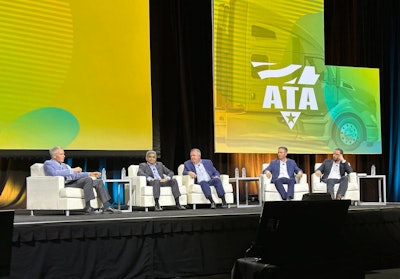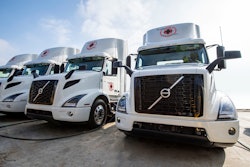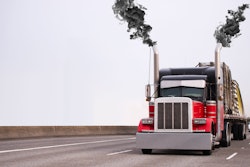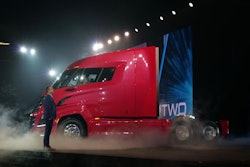
More than 98% of nitrogen oxides (NOx) and particulates have been taken out of emissions since 1988, said Bill Sullivan, executive vice president for advocacy at American Trucking Associations (ATA). But despite dramatic advances like that, the freight industry can’t keep pace with the policy and public discussion that continuously hurtles a growing list of acronyms from ESG (environmental, social and governance), NZEV (net zero emission vehicles) and BEV (battery electric vehicles) to ACF (advocacy coalition framework) and EJ (environmental justice) to name a few.
Sullivan sat down with a panel of experts at the ATA Management Conference & Exhibition this week to discuss the direction the industry, the country and the world are headed on such quickly and consistently evolving topics and what they’ve learned and the challenges they’ve faced in confronting state and federal regulators and lawmakers, as well as media and the public discussion, that distorts the industry’s options in picking winning and losing technologies before they're proven.
Srikanth Padmanabhan, president of the engine business at Cummins Inc., said the industry is headed for Destination Zero – Cummins’ terminology for its mission in meeting the world’s sustainability challenges.
“Net zero for me is something we have to do just for the fact that my grandkids should not ask me, ‘What were you doing in 2020 and 2030 that you could have left a better place for me,’” Padmanabhan said. “How do we get there? I think it is not a light switch event. It is going to take time. I also think it is going to happen in multiple ways. It’s not going to be one solution.”
Those solutions involve renewable diesel and renewable natural gas, hydrogen and battery electric, he said.
UPS (CCJ Top 250, No. 2) has been working toward a better future for decades, making investments in innovation, not driven by the government alone, driving efficiencies through route planning and more recently partnering with Cummins to roll out a significant natural gas fleet and taking that to the next level by using renewable natural gas.
UPS President of U.S. Government Affairs Michael Kiely said everyone talks about CO2, but methane is 80 times more toxic for the environment. He said many are focused on electric, but it’s important not to overlook current solutions like renewable natural gas that can have a major impact right now.
But regulations can hold companies back, Sullivan said.
“It's incredibly frustrating to me to have this discussion about either or: either we're all zero emission or it's drill baby drill,” he said. “It's getting harder to keep track of all the environmental regulations.”
Dave Williams, senior vice president of equipment and government relations at Knight-Swift Transportation (No. 5), said he thinks it’s always a mistake for the government to pick the winner. That’s what California has done with its zero-emission truck mandate, and Williams said other states will follow that lead.
“I think it's very important to open up the conversation again and start to look at all the possibilities. In other words, don't tell us how to get there. Tell us what your goal is and let us innovate,” he said.
Kiely said it has to be an all-of-the-above approach because every company runs different types of routes, hauls different types of freight and travels different types of roads, so they need different types of vehicles and specs for each one.
And Paul Enos, President and CEO of the Nevada Trucking Association, said electric isn’t the answer. He said it presents hours of service issues and a myriad of other problems that make the supply chain less resilient.
“The supply chain challenges that we are having today are just an appetizer of what is to come if we move to battery electric vehicles,” Enos said. “I’m not saying there isn't an application for battery electric or hydrogen or renewable natural gas, renewable diesel; there absolutely is, but we should be talking about what is the best for the supply chain, what is the best for the economy and ultimately what's best for the environment because where they are trying to take us today has tremendously more difficult environmental impacts and environmental challenges than carbon output.”
He said even if we can move to all electric, he isn’t sure we should because the environmental challenges and negative impacts on the water supply, land scarring and mineral scarcity is tremendously more complex and worse for the planet than burning diesel.
He said politicians, regulators and the media are taking an absolutist approach that “we’re going to die if we burn more carbon.”
Net Zero only exists in a very myopic look at tailpipe emissions, Enos said. The lifecycle emissions on a battery electric truck are 30% less than the internal combustion engine; it has significantly less energy density; it requires a tremendous amount of mining and natural resources; and those are natural resources that are difficult to get, he said.
““The laws of physics cannot be trumped by platitudes. They cannot be trumped by the laws of man … We need to get away from this catastrophizing and really take a more real-world (approach),” he said. “We are an industry that deals in the real world. We understand physics. We understand what it takes to get freight from point A to point B. Unfortunately, a lot of our politicians, a lot of our academics and a lot of people in the media don't have that connection that we do. We are, as an industry, in a phenomenal position to be able to push back and talk about those operational challenges to talk about what is going to happen to the grid if everybody goes electric.”
Kiely said Cummins engineered a natural gas engine with a diesel igniter that gave 20% more fuel efficiency. He said that engine “makes the most sense,” but regulations got in the way and made it too expensive to continue production.
Padmanabhan said he envisions a hybrid option in which you use electric when coming into a city center, for noise purposes or other reasons, and use an internal combustion engine otherwise. He also mentioned an internal combustion engine that runs on hydrogen. He said regulations should allow for a variety of solutions like this to make incremental improvements as the industry moves toward electric.
Williams said a hydrogen fuel cell is five times the cost of diesel at $10 to $12 per diesel equivalent gallon, but renewable diesel, on the other hand, would drop fuel emissions without having to change infrastructure or trucks.
The energy density of renewable diesel is almost on par with regular diesel fuel, Enos said. A gallon of diesel fuel puts 22.39 pounds of CO2 into the air while a gallon of renewable diesel puts out 7.84, but the feedstock for renewable diesel – corn and soy, which are things you could be using for food – are not available at scale, he said.
Williams argued that’s where you open all avenues.
“My mom always said moderation in all things,” Williams said. “If we did a little bit of this, a little bit of that, a little bit of diesel, a little bit of renewable, a little bit of battery electric, a little bit of hydrogen, I think there's probably an opportunity to make a real dent.”
Kiely said it’s essential for companies to purchase different types of trucks in small quantities to test them out and see what works. It is irresponsible, he said, to force companies, especially smaller trucking companies, to buy technology that hasn’t been tested at this point.
“I don’t see a smaller trucking company being able to survive some of those mandates,” he said.
And Williams said there needs to be national harmonization – one set of rules for all to follow – because different states creating different mandates doesn’t make sense across the board as trucks travel across state lines.
He said it comes back to allowing the industry to innovate to a positive result and not to innovate to the technology the government has already chosen.
“Historically, when we have a new technology that comes out, we've had time to develop, to work out the nuances, to figure out what works and what doesn't work and to adapt to that. Part of the challenge, I think, as an industry we're facing right now is that the timelines have been pulled up and the technology is not yet ready,” Williams said. “We're jumping from the bottom to the top without learning from the middle. I don't think there's anybody in this room that doesn't want clean air, clean water, a better environment. The question is are we going to get there in the right way? There's a chance here to spend perhaps trillions as an economy and not have a lot to show for it if we don't do it correctly.”













